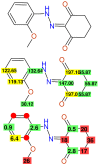The Advantage of Automatic Peer-Reviewing of 13C-NMR Reference Data Using the CSEARCH-Protocol
- PMID: 34200052
- PMCID: PMC8200238
- DOI: 10.3390/molecules26113413
The Advantage of Automatic Peer-Reviewing of 13C-NMR Reference Data Using the CSEARCH-Protocol
Abstract
A systematic investigation of the experimental 13C-NMR spectra published in Molecules during the period of 1996 to 2015 with respect to their quality using CSEARCH-technology is described. It is shown that the systematic application of the CSEARCH-Robot-Referee during the peer-reviewing process prohibits at least the most trivial assignment errors and wrong structure proposals. In many cases, the correction of the assignments/chemical shift values is possible by manual inspection of the published tables; in certain cases, reprocessing of the original experimental data might help to clarify the situation, showing the urgent need for a public domain repository. A comparison of the significant key numbers derived for Molecules against those of other important journals in the field of natural product chemistry shows a quite similar level of quality for all publishers responsible for the six journals under investigation. From the results of this study, general rules for data handling, data storage, and manuscript preparation can be derived, helping to increase the quality of published NMR-data and making these data available as validated reference material.
Keywords: 13C-NMR; NMR; computer-assisted peer-reviewing; database; spectrum prediction; structure generation.
Conflict of interest statement
The author declares no conflict of interest.
Figures





















Similar articles
-
A Critical Evaluation of the Quality of Published 13C NMR Data in Natural Product Chemistry.Prog Chem Org Nat Prod. 2017;105:137-215. doi: 10.1007/978-3-319-49712-9_3. Prog Chem Org Nat Prod. 2017. PMID: 28194563 Review.
-
[Analysis, identification and correction of some errors of model refseqs appeared in NCBI Human Gene Database by in silico cloning and experimental verification of novel human genes].Yi Chuan Xue Bao. 2004 May;31(5):431-43. Yi Chuan Xue Bao. 2004. PMID: 15478601 Chinese.
-
Automatic 13C chemical shift reference correction for unassigned protein NMR spectra.J Biomol NMR. 2018 Oct;72(1-2):11-28. doi: 10.1007/s10858-018-0202-5. Epub 2018 Aug 10. J Biomol NMR. 2018. PMID: 30097912 Free PMC article.
-
Influence of the completeness of chemical shift assignments on NMR structures obtained with automated NOE assignment.J Struct Funct Genomics. 2003;4(2-3):179-89. doi: 10.1023/a:1026122726574. J Struct Funct Genomics. 2003. PMID: 14649302
-
Human- and computer-accessible 2D correlation data for a more reliable structure determination of organic compounds. Future roles of researchers, software developers, spectrometer managers, journal editors, reviewers, publisher and database managers toward artificial-intelligence analysis of NMR spectra.Magn Reson Chem. 2017 Jan;55(1):7-14. doi: 10.1002/mrc.4527. Epub 2016 Oct 2. Magn Reson Chem. 2017. PMID: 27642110 Review.
Cited by
-
Antimicrobial Dihydroflavonols and Isoflavans Isolated from the Root Bark of Dalbergia gloveri.J Nat Prod. 2024 Sep 27;87(9):2263-2271. doi: 10.1021/acs.jnatprod.4c00690. Epub 2024 Sep 10. J Nat Prod. 2024. PMID: 39255387 Free PMC article.
-
Ecological and Pharmacological Activities of Polybrominated Diphenyl Ethers (PBDEs) from the Indonesian Marine Sponge Lamellodysidea herbacea.Mar Drugs. 2021 Oct 27;19(11):611. doi: 10.3390/md19110611. Mar Drugs. 2021. PMID: 34822482 Free PMC article.
-
Sampling CASE Application for the Quality Control of Published Natural Product Structures.Molecules. 2021 Dec 13;26(24):7543. doi: 10.3390/molecules26247543. Molecules. 2021. PMID: 34946623 Free PMC article.
-
Structure Elucidation of Secondary Metabolites: Current Frontiers and Lingering Pitfalls.Acc Chem Res. 2023 Jun 20;56(12):1656-1668. doi: 10.1021/acs.accounts.3c00183. Epub 2023 May 23. Acc Chem Res. 2023. PMID: 37220079 Free PMC article.
-
NMR-Based Chromatography Readouts: Indispensable Tools to "Translate" Analytical Features into Molecular Structures.Cells. 2022 Nov 7;11(21):3526. doi: 10.3390/cells11213526. Cells. 2022. PMID: 36359922 Free PMC article. Review.
References
-
- McAlpine J.B., Chen S.N., Kutateladze A., MacMillan J.B., Appendino G., Barison A., Beniddir M.A., Biavatti M.W., Bluml S., Boufridi A., et al. The value of universally available raw NMR data for transparency, reproducibility, and integrity in natural product research. Nat. Prod. Rep. 2019;36:35–107. doi: 10.1039/C7NP00064B. - DOI - PMC - PubMed
-
- Robien W. A Critical Evaluation of the Quality of Published 13C NMR Data in Natural Product Chemistry. In: Kinghorn A.D., Falk H., Gibbons S., Kobayashi J., editors. Progress in the Chemistry of Organic Natural Products. Volume 105. Springer International Publishing; Cham, Switzerland: 2017. pp. 137–215. - DOI - PubMed
-
- Bremser W. HOSE—A novel substructure code. Anal. Chim. Acta. 1978;103:355–365. doi: 10.1016/S0003-2670(01)83100-7. - DOI
-
- Purtuc V. Master’s Thesis. University of Vienna; Vienna, Austria: 1997. Abschätzung von 13C-NMR-Spektren Mittels Neuronaler Netze.
LinkOut - more resources
Full Text Sources

